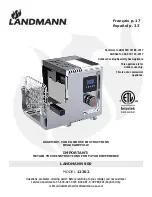
ENGLISH
CARBON BRUSHES
The brushes and commutator in your tool have been
engineered for many hours of dependable service.
In order to prepare your brushes for use, run your tool at full
speed for 5 minutes under no load. This will properly “seat”
your brushes, which extends the life of both your brushes
and your tool.
To maintain peak efficiency of the motor, we recommend
every 40 - 50 hours the brush es be examined. Only original
replacement brushes specially designed for your tool
should be used.
MAINTENANCE OF REPLACEABLE BRUSHES
The brushes should be inspected frequently when tools are
used continuously. If your tool runs spo rad ically, loses
power, makes unusual noises or runs at a reduced speed,
check the brushes.
To continue using the tool in this condition
will permanently damage your tool.
Siga estos pasos para revisar y cambiar las escobillas de la
herramienta rotatoria.
Follow these steps to check/change the rotary tool brushes:
1. With the power cord unplugged, place the tool on a clean
surface. Use the tool wrench as a screwdriver to remove the
brush caps in a counter-clockwise direction.
2. Remove the brushes from the tool by pulling on the spring
that is attached to the carbon brush. If the brush is less than
1/8" long and the end surface of the brush that contacts the
commutator is rough and/or pitted, they should be replaced.
Check both brushes.
Usually the brushes will not wear out simultaneously. If one
brush is worn out, replace both brushes. Make sure the
brushes are installed as illus trated. The curved surface of
the brush must match the curvature of the commutator.
3. After replacing brushes the tool should be run at no-load;
place it on a clean surface and run it freely at full speed for 5
minutes before loading (or using) the tool. This will allow the
brushes to “seat” properly and will give you more hours of
life from each set of brushes. This will also extend the total
life of your tool since the com mutator surface will “wear”
longer.
BEARINGS
This model features a double ball bearing construction.
Under normal use they will not require lubrication.
Cleaning
To avoid accidents always dis connect the
tool from the power supply before
cleaning or performing any main tenance.
The tool may
be cleaned most effectively with compressed dry air.
Always wear safety gog gles when cleaning tools with
compressed air.
Ventilation openings and switch levers must be kept clean
and free of foreign matter. Do not at tempt to clean by
inserting pointed objects through openings.
Certain cleaning agents and sol vents
damage plastic parts.
Some of these are:
gasoline, carbon tetrachlo ride, chlo rinated cleaning
solvents, ammonia and house hold detergents that contain
ammonia.
Extension Cords
If an extension cord is necessary, a cord
with adequate size conductors that is
capable of carrying the current necessary for your tool
must be used.
This will prevent excessive voltage drop,
loss of power or overheating. Grounded tools must use 3-
wire extension cords that have 3-prong plugs and
receptacles.
NOTE:
The smaller the gauge number, the heav i er the
cord.
RECOMMENDED SIZES OF EXTENSION CORDS 120
VOLT ALTERNATING CURRENT TOOLS
18
18
C AU T I O N
!
M U
L T I
D R I
L L 1
3 0
M U
L T I
D R I
L L 1
3 0
BRUSH
CAP
COLLET
WRENCH
BRUSH
CURVED END OF BRUSH MUST
MATCH CURVATURE OF HOUSING
BRUSH
SPRING
WARNING
!
WARNING
!
C AU T I O N
!
Tool’s
Ampere
Rating
3-6
6-8
8-10
10-12
12-16
Cord Size in A.W.G.
2
Wire Sizes in mm
Cord Length in Feet
Cord Length in Meter
25
18
18
18
16
14
50
16
16
16
16
12
100
16
14
14
14
-
150
14
12
12
12
-
15
0,75
0,75
0,75
1,0
-
30
0,75
1,0
1,0
2,5
-
60
1,5
2,5
2,5
4,0
-
120
2,5
4,0
4,0
-
-
















































